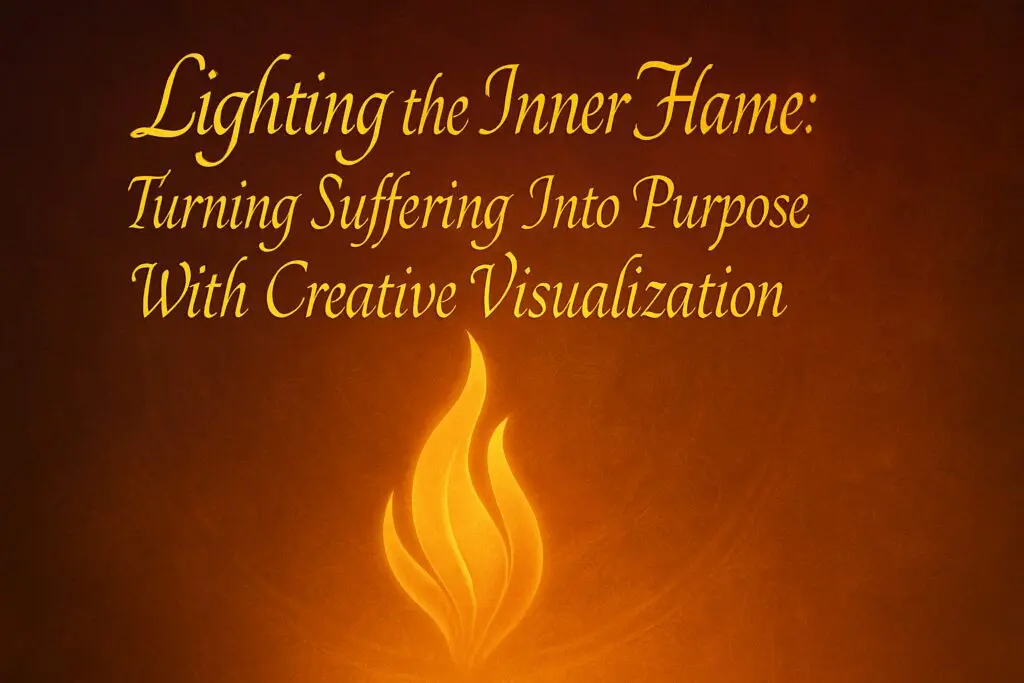Have you ever found yourself tangled in a web of suffering, only to wonder if there’s any meaning behind it? I’ll never forget a cold November afternoon – it was one of those days I couldn’t shake a sense of loss. Instead of fighting the feeling, I sat down, closed my eyes, and tried to focus on a tiny spark I imagined right at the center of my chest. It’s wild how something so simple can feel so real and powerful. Turns out, tapping into this ‘inner flame’ (a term I’d never heard until recently) can be a turning point, a secret ally for anyone feeling lost or burdened by old wounds. Today, let’s dig into what it truly means to transform suffering into clarity and purpose—beyond wishful thinking, using creative visualization as a bridge between pain and meaning.
Why Do We Suffer? (And What If It’s Not All Bad?)
When you think about suffering, it’s easy to see it as something to avoid at all costs. But what if suffering isn’t random? What if, instead, it’s a signal—pointing you toward the places where your greatest gifts are hidden? This idea might sound surprising, but it’s a powerful shift in perspective, especially if you’re interested in transforming suffering into personal growth.
Let’s start at the beginning. Many spiritual traditions and modern thinkers suggest that before you’re born, you have a sense of who you are and why you’re here. But as soon as you arrive in this world, you forget. That forgetting is universal. It’s almost as if it’s built into the human experience. And while it can be painful, some believe this forgetting has a purpose. It creates a longing, a sense of searching, that can guide you back to your deeper self.
So, why do we suffer? One answer is that suffering acts as a kind of wayshower. It’s not just a byproduct of life’s challenges—it’s a signpost, steering you toward transformation. When you experience pain, frustration, or loss, it’s often because something important is being blocked or hidden. Research shows that suffering often points to areas of potential growth and contains hidden gifts. In fact, as one expert puts it:
“In the suffering, there is a gift. And typically, where the suffering is the most excruciating, bigger gifts are hiding.”
But what creates these blocks in the first place? The roots of suffering are complex. Sometimes, it’s obvious: a traumatic event, a difficult relationship, or an unsupportive environment. Other times, the origins are hidden. You might carry pain that isn’t even yours—patterns passed down through your family, or even from previous generations. Studies indicate that trauma and limiting beliefs can be inherited, shaping your experience in ways you may not consciously recognize.
These inherited and learned patterns can be powerful. For example, you might have internalized beliefs like “I can’t” or “I don’t deserve.” These aren’t just thoughts—they’re barriers that keep you from your authentic self. Over time, these beliefs become invisible walls, separating you from your purpose and potential. Recognizing these patterns is essential for transformation. Healing trauma techniques, such as creative visualization, can help you identify and release these blocks, opening the door to personal growth.
It’s not just family or trauma, either. Environmental factors play a big role in shaping your experience of suffering. Where you grow up, the culture you’re surrounded by, even the weather and the land—all these things influence how you see yourself and what you believe is possible. Sometimes, the environment supports your growth. Other times, it adds to your challenges, making it harder to reconnect with your deeper purpose.
Another layer to consider is the accumulation of trauma. Unlike most animals, people don’t always know how to “shake off” difficult experiences. Instead, you might surround your pain with protective barriers—energetic bubbles that are meant to keep you safe. But triggers can still break through, reactivating old wounds. Over time, these bubbles can attract more negativity, making the suffering feel even heavier. This is where transforming suffering becomes crucial. By learning to recognize and release these patterns, you can begin to uncover the gifts hidden within your pain.
Sometimes, suffering shows up in specific areas of life—like abundance, relationships, or self-acceptance. You might feel blocked in your career, struggle to connect with others, or find it hard to accept yourself as you are. These challenges often have roots in the past, whether from your own experiences or those of your ancestors. Healing trauma techniques and personal growth practices can help you break these cycles, allowing you to move forward with greater clarity and purpose.
Ultimately, suffering is both a universal human experience and a potential path to growth. It’s not just something to endure—it’s something to explore. When you approach your pain with curiosity and compassion, you may discover that within it lie the seeds of your greatest strengths. Transforming suffering isn’t easy, but it’s possible. And sometimes, the journey itself is where you find your true purpose.
The Inner Flame: Visualization as a Tool for Healing and Clarity
Imagine a small, steady flame at the center of your chest. This is your inner flame—a mental image that serves as both a literal and metaphorical focal point in guided visualization and inner flame meditation. When you bring your awareness to this inner spark, you tap into a powerful tool for healing, clarity, and transformation.
The practice begins with your breath. As you inhale, you draw in what your soul and body need. As you exhale, you release what no longer serves you—physical discomfort, emotional pain, or lingering negativity. This simple act of breathing, paired with focused attention on your inner flame, sets the stage for clarity through visualization.
Connecting With the Inner Flame
Your inner flame is always present. From the moment you are conceived, it exists within you and remains as long as you inhabit your body. It is a direct link to your own divinity, a bridge between your personal experience and the universal creative force. When you feel lost or disconnected, remembering this flame can ground you. It reminds you that you are not random or unseen, but deeply connected to something greater.
Research shows that creative visualization practice—especially when centered on a personal symbol like the inner flame—can catalyze healing and insight. By focusing on this spark, you nurture it. As one teaching puts it:
“When you focus on this spark or inner flame, they grow. And as you focus on the movement of the flame… it is the healer.”
This flame does not burn in the physical sense, but it may feel warm or appear in different colors as you visualize it. Pay attention to how you perceive it in your body. The more you focus, the more tangible it becomes, acting as a gentle healer and a source of stillness—an anchor outside of time.
Guided Visualization: Moving Through the Void
A key part of guided visualization is creating detailed inner experiences. With the inner flame, you might notice a dark area at its base. This is not something to fear; it is an entry point into the void—a realm of all potentialities. In this space, you are free from identity, floating weightless, open to possibilities. The void is where the breath of creation moves, where anything can take form.
You can use this visualization to release suffering. Imagine your trauma, pain, or old wounds being drawn into the flame and transformed. Let the flame consume what you no longer need, turning suffering into clarity and purpose. This process is not about erasing your past, but about integrating it and finding meaning within it.
From Personal Pain to Universal Connection
Visualization connects the personal—your suffering, your story—with the universal creative force. The inner flame is both yours and a part of something endless. When you release negativity into this flame, you are not just letting go; you are participating in a larger cycle of transformation. This act of surrender allows you to gain clarity, even when circumstances are far from perfect.
Studies indicate that clarity through visualization does not require ideal conditions. It is a gift that comes from your willingness to face the truth, to sit with discomfort, and to trust the process. The inner flame becomes a steady point of focus, especially when you are working through old wounds or seeking direction.
- Daily Practice: Make it a habit to connect with your inner flame. Even a few moments of focused attention can ground you and promote healing.
- Release and Renew: Use your breath to draw in what you need and let go of what you don’t. Visualize the flame transforming your pain into clarity.
- Explore the Void: When ready, allow yourself to pass through the dark area of the flame into the void. Here, you can ask for guidance, new possibilities, or simply rest in the realm of all potential.
The inner flame is always waiting for you to remember it. Through guided visualization and inner flame meditation, you can transform suffering into purpose, connecting your personal journey with the universal dance of creation.
Flipping the Script: Suffering as a Springboard to Authentic Purpose
When you think about purpose and clarity, it’s easy to fall into the trap of believing these are things you must chase or earn through hardship. But what if suffering itself could become the very springboard that launches you into a life of authentic living and genuine self-expression? This is where creative visualization steps in—not as a quick fix, but as a gentle, powerful tool for transforming pain into purpose.
At the heart of life purpose discovery is the freedom to express who you truly are, without fear or masks. Many people spend years trying to fit into roles or expectations that don’t feel right, believing that purpose is a job title or a single achievement. In reality, research shows that true purpose is about authentic self-expression, not external roles. It’s about letting your inner flame burn in its own unique way, even if that means embracing the messiness of your journey.
Visualization is more than just daydreaming. It’s an intentional practice where you create detailed mental images of what you want to experience or become. In the context of healing and growth, visualization can help move emotional blockages and dissolve old ‘contracts’—those unspoken agreements or patterns that hold you back from authentic living. Studies indicate that visualization techniques, such as guided meditation or vision boards, can help you clarify your goals, reduce stress, and even boost confidence. When you visualize your purpose, you’re not just imagining a better future; you’re actively shaping your mindset and opening yourself to new possibilities.
Imagine, for a moment, a universal flame coming to you—not just from above, but from all directions, even through the soles of your feet. This flame brings clarity, not as a sudden revelation, but as a gentle gift. You might not know exactly what you need clarity for, but you can simply ask for the virtue of clarity to enter your life. This is the beginning of aligning with your personal and spiritual destiny. As you let go of negative patterns and old suffering, you create space for new insights and gifts to emerge.
In many visualization practices, you’re invited to notice what you receive after releasing what no longer serves you. Sometimes, this comes in the form of a symbolic gift—a tiny book or box placed gently in your hands. This isn’t just a metaphor; it’s a reminder that your unique talents and clarity about your soul’s path are always available to you, unfolding in their own time. The book or box represents your gifts, your skills, and a deeper understanding of how to use them. It also brings additional clarity about your life purpose, reinforcing the idea that your purpose is not fixed, but evolves as you grow.
“Remember that your life purpose is completely imbued with authenticity and freedom to be who you came here to be, and then that’s alignment.”
This is the essence of authentic living. When you align with your true self, you allow creation to move through you. The divine will becomes your will, and you find yourself creating and living in a way that feels simple, natural, and right. The symbolic book or box you receive in visualization may not open immediately. Sometimes, its contents are revealed slowly, as you’re ready to receive them. Trust that you’ll be informed and guided as you need, and that your journey is unfolding exactly as it should.
The practice of turning suffering into purpose isn’t about denying pain or pretending everything is perfect. It’s about embracing the journey, including the mess and uncertainty, and being open to the gifts that come from it. Visualization helps you not only release suffering but also actively receive clarity and purpose. It encourages you to trust the process, knowing that your life purpose is less about what you do and more about who you are—free, authentic, and aligned with your deepest truth.
As you continue on your path, remember that purpose and clarity are not destinations, but ongoing processes. By flipping the script on suffering and using creative visualization, you can transform even your most difficult experiences into stepping stones toward a more authentic, purposeful life. The flame within you is always ready to light the way.




